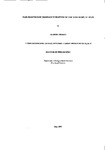Plio-Pleistocene Drainage Evolution of The Vera Basin, SE Spain
| dc.contributor.author | Stokes, Martin | |
| dc.contributor.other | School of Geography, Earth and Environmental Sciences | en_US |
| dc.date.accessioned | 2013-09-18T09:43:30Z | |
| dc.date.available | 2013-09-18T09:43:30Z | |
| dc.date.issued | 1997 | |
| dc.identifier | NOT AVAILABLE | en_US |
| dc.identifier.uri | http://hdl.handle.net/10026.1/1826 | |
| dc.description | Merged with duplicate record 10026.1/1289 on 14.03.2017 by CS (TIS) | |
| dc.description.abstract |
The Vera Basin is used as a case study to examine the structural evolution and sedimentary response of a basin undergoing uplift and inversion during the Plio-Pleistocene. Particular emphasis is placed on the drainage evolution during that period. Located within the Internal zone of the Betic Cordilleras, the Vera Basin is defined within a large left-lateral shear zone and has evolved as a reponse to isostatic uplift from nappe emplacement during the Oligocene, and by regional compressive tectonics. Since basin formation during the Seravallian, sedimentary fill has been dominantly marine. During the Plio-Pleistocene a switch from marine to continental conditions occurred. These sediments (Cuevas, Espiritu Santo and Salmcr6n Formations) represent the final stages of basin fill and form the focus of this study. The Cuevas Formation represents an early Pliocene marine transgression within the Vera Basin. Early sedimentation infilled a pronounced submarine topography produced by a rapid laie Miocene fall in sca- level. A broad, shallow shelf platform area existed which opened out to the Pliocene Mediterranean Sea towards the east. Along the northern and western basin margins, wave dominated shorelines were formed. Structural activity was confined to low amounts of basin subsidence and limited left lateral strike-slip movement along the Palomares Fault Zone. The Espiritu Santo Formation marks a major palaeogcographic reorganisation and the final marine phases of the Vera Basin during the mid to late Pliocene. Unsteady strike-slip movement along the Palomarcs fault zone on the eastern basin margin partially enclosed the Vera Basin by northwards movement of a structurally detached landmass. Gilbert-type fan-delta bodies prograded westwards from the landmass (Sierra Almagrera), infilling the central region of the basin. Early fan-delta sediments were reworked into shoreline areas along the western and northern basin margins. Western margin shorelines retreated northwards as a response to partial enclosure and a gradual lowering of sea-level. Late stages of the Espiritu Santo Formation, saw a fan-delta body prograde from the northern basin margins. Interaction between the basinal and marginal fan-delta bodies enclosed the northern region of the Vera Basin. A swamp/mangrove environment developed within the enclosed northern basin area suggesting a humid, sub-tropical climntc. Continental conditions were established during Salmer6n Formation times in the late Pliocene. Along the western and northern basin margins, the retreating Pliocene shorelines provided a topography onto which the primary consequent drainage network developed. Three separate drainage systems can be identified on the basis of clast assemblages, palaeocurrents, depositional style and morphological expression. Early deposition was characterised by the progradation of alluvial fans of two drainage systems (Cuevas & Jauro), sourced from the northern and western basin margins. Distal areas of the northern fan system intercalated with an evaporitic playa lake. A third drainage system in the northwest of the basin (Salmeron) developed within a topographic low between the two fan systems. An increase in structural activity towards the end of the Salmeron Formation was characterised by a basin wide phase of north-south compression. Uplift and extensional faulting lead to abandonment of the primary drainage network. Fan entrenchment and minor rerouting of sediment supplies marked the establishment of a new secondary consequent drainage network during the Pleistocene. The Pleistocene drainage network records the progressive dissection of the Vera Basin as a response to ongoing regional epeirogenic uplift. During this post-inversion phase the Rios Antas, Almanzora and Aguas developed respectively along the western, northern and southern basin margins as a series of braided streams. Distal, coastal areas of this drainage network are recorded by a series of Pleistocene shoreline sequences which developed as a response to fluctuating sea-level during the Pleistocene glacial and inlerglacial periods. Early Pleistocene proximal parts of the drainage network are well preserved. Distal parts of the Pleistocene fluvial system display limited evidence for interaction between the drainage network and shoreline sequences. This lack of preservation relates to the high energy, wave dominated deposilional setting of the Pleistocene shoreline areas which reworked fluvial sediment inputs into the shoreline environment. The Plio-Pleistocene evolution of the Vera Basin, and in particular the development of the fluvial system during this period has been highly complex. Despite the importance of sea-level and climatic controls, tectonic activity during this period of basin inversion has been the dominant control on the positioning of the drainage networks, depositional styles and sediment supply. | en_US |
| dc.language.iso | en | en_US |
| dc.publisher | University of Plymouth | en_US |
| dc.title | Plio-Pleistocene Drainage Evolution of The Vera Basin, SE Spain | en_US |
| dc.type | Thesis | |
| plymouth.version | Full version | en_US |
| dc.identifier.doi | http://dx.doi.org/10.24382/3819 | |
| dc.identifier.doi | http://dx.doi.org/10.24382/3819 |
Files in this item
This item appears in the following Collection(s)
-
01 Research Theses Main Collection
Research Theses Main


